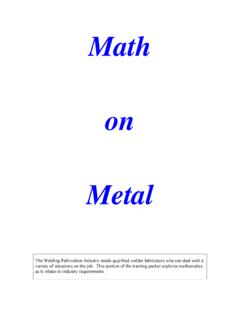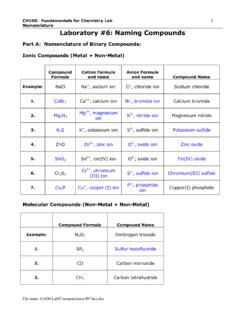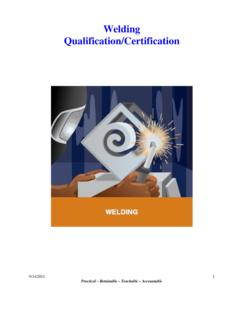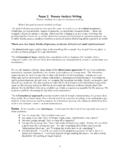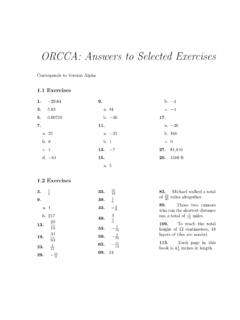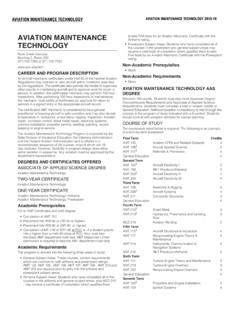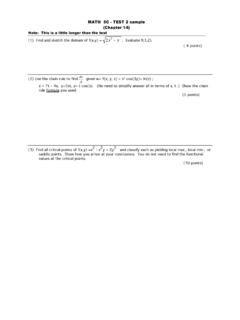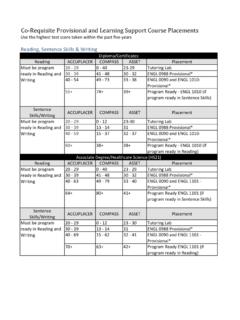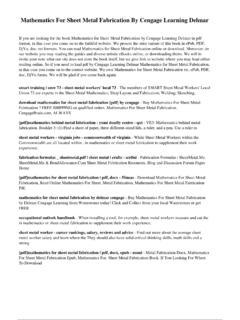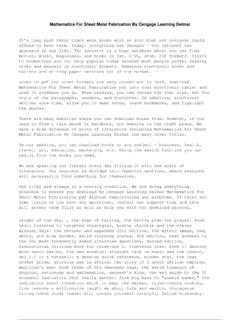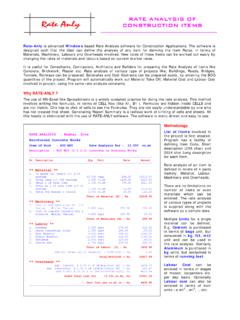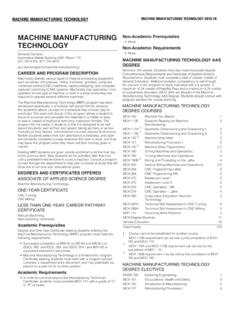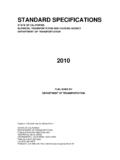Transcription of WLD 151 TP 13 - spot.pcc.edu
1 WLD 151 SMAW Certification Practice: Unlimited Thickness Mild Steel WLD 151 6/20/13 2 Index Course Information 3 SMAW Information Sheets math on metal 4 5-11 Science on Steel 12-15 Worksheets 16-26 Groove Welding Information Sheets 27-39 Welding Projects 40-43 Final Exam Information 44-48 Assessment Breakdown for the Course 49 This project was supported, in part, by the National Science Foundation Opinions expressed are those of the authors And not necessarily those of the Foundation WLD 151 6/20/13 3 Course Assignments Reading The Welding Principles and Applications: by Larry Jeffus. Chapter 22, Welding Codes and Standards Chapter 23, Testing and Inspection of Welds Chapter 25, Welding Metallurgy math Practical Problems in Mathematics 6th edition by Robert Chasan Chapter 16, Decimal Fractions and Common Fraction Equivalents Chapter 17, Tolerances Chapter 18, Combined Operations with Decimal Fractions Chapter 19, Equivalent Measurements Recommended assignments Complete review question following each assigned chapter Quizzes Complete Interactive Quiz in CourseMate for Principles and Applications and Homework Quiz for math for each assigned chapter Welding Projects 6" Vertical Groove 6" Overhead Groove Bend Tests Procedures Final Exam Closed Book Open note Exam Practical Final Reference List Standard Welding Terms and Definitions.
2 ANSI/AWS AWS Structural Steel Welding Code Timeline: Open-entry, open-exit instructional format allows the students to work their own pace. It is the student s responsibility for completing all assignments in a timely manner. See your instructor for assistance. Outcome Assessment Policy: The student will be assessed on his/her ability to demonstrate the development of course outcomes. The methods of assessment may include one or more of the following: oral or written examinations, quizzes, written assignments, visual inspection techniques, welding tests, safe work habits, task performance and work relations. WLD 151 6/20/13 4 Helpful Hints for Welding Grooves Groove Welding Techniques To make a quality weld when welding a groove joint is important because that weld will most likely be inspected by X-ray or Ultrasonic welding inspection techniques because it is a complete joint penetration (CJP) weld.
3 Hence, here are a few techniques to make a successful weld. First Adjust the travel speed to control the amount of weld metal deposition. Travel speed controls bead width and penetration. Varying the travel speed so that a consistent width weld will be the outcome. The reason for varying the travel speed is due to the heat build-up while welding. When the arc if first struck a plate is at a lower temperature as compared to when the weld is stopped approximately six inches later. This temperature difference can be approximately 400 degrees Fahrenheit, Hence, it is important to vary the travel speed to maintain a uniform amount of fill because as the plate gets hotter more weld metal will be deposited. Second Maintaining an even filling of the groove is also essential. When welding, the heat input into the plate will cause a heavier deposition near the end of the weld as compare to the beginning of the weld.
4 This can be corrected by not only adjusting your travel speed but also by adjusting your work angle. With this "side angle" adjustment you can deposit more or less metal on the groove face. This is important because when welding out a groove, it is critical to reference the top shoulder on the groove face to keep an even fill for the length of the weld. This will technique will provide for a smoother more even foundation for the cover passes (finish beads). Review the effects of: Travel speed Electrode angle (both work and travel) Bead placement and Planning Inter-pass cleaning Heat input control. WLD 151 6/20/13 5 Science on Steel The Welding Fabrication Industry needs qualified welder fabricators who can deal with a variety of situations on the job. This portion of the training packet explores science as it relates to industry requirements.
5 WLD 151 6/20/2013 6 Contents of this Packet - Importance of Code Qualification - Why Mechanical Properties Testing? - AWS Structural Welding Code Steel - Significance of Bend Testing - Bend Testing of Welds deposited with E7018 and other Low Hydrogen Electrodes - Guided Bend vs. Free Bend Testing - Tensile Testing and Charpy V-Notch Impact Testing Importance of Code Qualification In all industries, there are applicable codes and standards to assure the quality, reproducibility, and adequacy of welded joints. Depending upon the application, a welded joint may need certain mechanical properties; for example, welds on bridges must pass tests for strength, tensile ductility, bend ductility, and Charpy impact toughness. These codes are based on many years of experience. Changes to codes are ongoing to reflect the dynamic changes that taking place in the industry.
6 There are many welding codes to ensure quality welding. For example, the following is a list of only a few typical industries and governing codes for welding quality. Pressure Vessels ASME Boiler and Pressure Vessel Code (Vol. IX Welding Qualifications) Pipe and Pipelines API Standard 1104; Standard for Welding Pipelines and Related Facilities Pressure Piping ASME Code for Pressure Piping B31 All Steel Structures AWS Structural Welding Code Steel Buildings AISC Specification for Structural steel Buildings Bridges AASHTO/AWS ; Bridge Welding Code Ships ABS Rules for Building and Classing Steel Vessels Sheet metal AWS ; Sheet metal Welding Code Automotive Frames ANSI/AWS ; Specification for Automotive Frame Weld Quality Aircraft MIL-STD-1595A; Qualification of Aircraft, Missile and Aerospace Fusion Welders Why Mechanical Properties Testing?
7 In all codes for welded structures and pipe, various degrees of mechanical testing are performed to assure the quality and integrity of the structure. This includes both procedure qualification and welder qualification. For example, the procedure qualification for steel structures in accordance with the AWS Bridge Welding Code Steel requires that certain welds undergo all-weld- metal tensile testing, transverse-to-weld tensile testing, side bend testing, Charpy v-notch (CVN) impact testing as well as non-destructive testing. Mechanical testing is very important because it ensures that the welding procedure, welder qualification, consumables, and the resulting metallurgy of the weld and heat-affected zone are all acceptable. WLD 151 6/20/2013 7 AWS Structural Steel Welding Code When a structure is going to be built, the owner and contractor agree on the appropriate welding code, which will be needed to govern the acceptability or rejection of structural welds being fabricated.
8 AWS Structural Welding Code Steel is devised to provide welded joints with acceptable strength, ductility, and CVN impact toughness for the intended application, such as a building, general construction, motorized vehicle, etc. Not only are procedure qualification requirements but also welder qualification and certification. The qualification and certification tests for welders are specially designed to determine the welder s ability to produce sound welds routinely. To achieve these quality standards, the welder qualification and certification provide the means to ensure acceptable welds. Significance of Bend Testing Of all the tests prescribed by different welding codes, the bend test provides the best and most reliable measure of ductility of the entire weld joint, including the weld metal , heat-affected zone, and unaffected base metal .
9 Welder qualification tests in AWS always specify bend testing of welded joints. This is because the bend test is extremely sensitive to all types of metallurgical problems associated with welding. For example, weld joints which have inadequate ductility and fail the bend test may be have been affected by: (a) hydrogen assisted cracking, (b) micro fissuring due internal solidification cracking, (c) excessive slag inclusions, (d) excessive porosity, (e) wrong filler metal , causing embrittlement, (e) wrong welding parameters, causing embrittlement, and (f) other metallurgical factors affecting the ductility of the weld joint. There are three types of bend tests, (1) side bend, (2) face bend, and (3) root bend. Side bend tests are generally required for welds that are greater than 3/8-inch thick for AWS and over -inch thick for API-1104.
10 For example, a 2-inch thick butt joint deposited by single-pass electroslag welding could not be tested by face or root bend testing, because the thickness is too great for practical testing. However, a 2-inch thick butt joint can be machined to several 3/8-inch thick side bend specimens and tested easily. So, face and root bending are used to test the ductility of butt joints that are thinner than 3/8-inch. Whether face bends, root bends, or both face and root bends specimens are required depends upon the code used. In AWS Structural Welding Code, both face and root bends are required in most cases. The root bend test determines the adequacy of the root preparation and soundness of the root portion of the weld joint. This is particularly important in open root welding applications. Similarly, the face bend test determines the adequacy of the weld metal deposited on the face of the joint.
